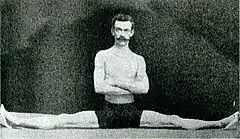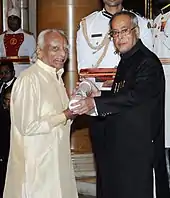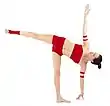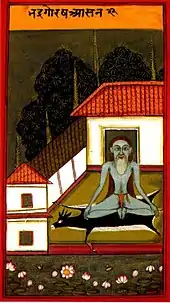Mark Singleton (yoga scholar)
Mark Singleton (born 1972) is a scholar of yoga and Senior Research Fellow at SOAS, University of London, where he works on the European Research Council-funded Hatha Yoga Project.[1] He is the author of the widely-read study of modern postural yoga Yoga Body : the Origins of Modern Posture Practice (2010), based on his PhD thesis; it argued that certain posture-based forms of modern yoga represent, in large part, a radical break from haṭha yoga tradition, with different goals, and an unprecedented emphasis on āsanas. His 2017 book Roots of Yoga is an extensive collection of translations of yoga practice texts. He has written many academic articles and edited three collections of scholarship on yoga.
Mark Singleton | |
|---|---|
| Born | 1972 |
| Nationality | British |
| Occupation | Yoga scholar |
| Known for | Yoga Body (2010), thesis: modern yoga was shaped in 20th century |
Biography

Mark Singleton spent three years in India in the 1990s learning yoga intensively, both physically and mentally, and discovering that authentic, traditional Indian yoga was strikingly difficult to find: the classes and workshops that he took were aimed mostly at "Western yoga pilgrims".[3] He practised yoga for two and a half hours early each morning, spent the day studying the history and philosophy of yoga, and then taught or attended a yoga class. His discovery that modern āsana-based yoga had much more recent origins than was claimed for it caused him "something like a crisis of faith".[3]
Returning to England, he gained his Ph.D. in divinity at Cambridge University under the supervision of Elizabeth De Michelis.[4] He is a qualified teacher of Iyengar Yoga and Satyananda Yoga.[4] From 2006 to 2013 he taught at St John's College, Santa Fe.[5]
In 2009, he and Jean Byrne edited the collection Yoga in the Modern World.[6]
In 2010 Singleton published a revised version of his Ph.D. thesis on modern yoga, Yoga Body: The Origins of Modern Posture Practice; it argues that certain modern forms of yoga represent a radical reworking of the haṭha yoga tradition in both content (dropping most haṭha practices other than āsanas) and purpose (exercise rather than mokṣa, spiritual liberation), and that the incorporation of many standing āsanas into popular yoga reflects the rise of systems of modern physical culture (such as Niels Bukh's Primitive Gymnastics) widespread in India during the 20th century.[7] He has written about his work in The New York Times and the Yoga Journal,[4][8] including a tribute to B. K. S. Iyengar.[9]
He is a researcher at the School of Oriental and African Studies in London. He was co-chair for the American Academy of Religions group studying yoga in theory and practice.[10] In 2013, he served as consultant for the Smithsonian exhibition Yoga: The Art of Transformation, contributing also to the exhibition catalogue.[11]
In 2014, he and Ellen Goldberg edited the collection Gurus of Modern Yoga.[12]
In 2016, his work was featured in a BBC Radio 4 program by Mukti Jain Campion entitled "The Secret History of Yoga".[13]
In 2017, he co-authored with James Mallinson the book Roots of Yoga, a collection of mostly original translations of over one hundred yoga texts, mainly from Sanskrit but also including Tibetan, Arabic, Persian, Bengali, Tamil, Pali, Kashmiri, and early forms of Marathi and Hindi. Its eleven themed chapters cover many of the traditional practices of yoga (such as āsana, prāṇāyāma, mudrā, meditation, and mantra) as well as essential contexts for practising yoga (such as preliminaries to yoga practice, the yogic body, special powers (siddhi), and liberation (mokṣa)).[14] The book has a main introduction summarizing the history of yoga and yoga scholarship, and each chapter has its own shorter contextual introduction and notes.
Reception

Yoga Body
Harold Coward, reviewing Yoga Body for the Journal of Hindu-Christian Studies, admired its analysis and accessibility.[15] The yoga instructor Timothy Burgin, reviewing it for Yoga Basics, calls it "fascinating and remarkable", both well-documented and likely to "ruffle a few yogis' feathers".[16] The yoga teacher Jill Miller, reviewing the book on Gaiam, observes that the book agreed with the intuition that many āsanas were similar to those in martial arts, and that authenticity in yoga was not what it seemed.[17] The author Matthew Remski, writing in Yoga International, called the publication "a watershed moment in the history of global asana culture." He agrees that the book is "uncomfortable", gently deconstructing terms like "original" and "authentic", pointing instead to the student-teacher relationship. He finds the book strongly "yogic", weaving together "the cultural and the personal".[18]
Yoga in the Modern World

The researcher Suzanne Newcombe, reviewing the collection Yoga in the Modern World edited by Singleton and Jean Byrne, notes that several of the chapters "successfully combine emic experience with an etic analysis. Burley and Liberman openly declare that, in addition to being established scholars, they also teach forms of modern yoga. For Nevrin, Smith, and Strauss, experiencing the practice of yoga is an inherent part of a rigorous anthropological understanding that acknowledges embodied experience."[19] In her view, "rigorous academic reflection" on modern yoga is an "interesting" development, making the book a valuable overview of the field.[19]
Gurus of Modern Yoga
Miriam Y. Perkins, reviewing Gurus of Modern Yoga for Spiritus: A Journal of Christian Spirituality, writes that the book provides a "compendium of multiple and influential yoga philosophies and their spiritual founders" with a "sound and balanced entry into this complexity and helpful orientation to the dynamics of popular spiritual seeking through related practices."[20] She finds its inclusion of women gurus "an important contribution".[20]
Jeffrey D. Long, in his review essay in the Religious Studies Review, calls the volume "outstanding".[21]
Roots of Yoga
Neil Sims, reviewing Roots of Yoga on the Indian Philosophy Blog, calls the book scholarly, writing that the editors (Mallinson and Singleton) "do an admirable job of letting the texts speak for themselves. No hint of partisanship, or even a preferred view, is given." In Mills's view, the book succeeds both on the level of increasing historical understanding among yoga students and teachers, and in contributing to yoga and South Asian scholarship.[22]
In a review in Yoga Journal, Matthew Remski points to the book's "endlessly diverse sources", which include "new critical translations of over 100 little-known yoga texts dating from 1000 BCE to the 19th century, threaded together with clear and steady-as-she-goes commentary". The translations, he states, "explode the available resources for everyday practitioners." Remski proposes that it may "become the top book on every yoga teacher training reading list in the English-speaking world."[23]
The researcher Adrian Munoz, reviewing the book in Estudios de Asia y África, notes that while it is principally a sourcebook of "innumerable" yoga manuscripts, mainly in Sanskrit, rather than the presentation of any particular thesis, it is accompanied by an erudite 30-page introduction that sets the documents in their historical context.[24]
The yoga teacher Richard Rosen writes that Roots of Yoga is appropriately in Penguin Classics as "this monumental anthology" of some 150 primary Sanskrit sources is destined to become a classic.[25]
The Indologist Alexis Sanderson writes that the anthology's "unprecedented array of sources [...] will be an indispensable companion for all interested in yoga, both scholars and practitioners".[26]
References
- "The Hatha Yoga Project". SOAS. Retrieved 17 May 2019.
- Singleton 2010, pp. 198-205.
- Singleton, Mark (16 April 2018). "The Ancient & Modern Roots of Yoga". Yoga Journal.
- "Sharing Knowledge". Retrieved 8 February 2019.
- "Why Review Standards?". Yoga Alliance Standards Review Project. 2017-11-07. Retrieved 8 February 2019.
- Singleton & Byrne 2009.
- Singleton 2010, pp. whole book, esp. 198-205.
- Singleton, Mark (4 February 2011). "The Ancient & Modern Roots of Yoga". Yoga Journal. Retrieved 8 February 2019.
- Singleton, Mark (6 October 2014). "Honoring B.K.S. Iyengar: Yoga Luminary". Yoga Journal. Retrieved 8 February 2019.
- "Mark Singleton". Yoga Campus.
- "Yoga: The Art of Transformation". Smithsonian. 2013. Retrieved 8 February 2019.
- Singleton & Goldberg 2014.
- "BBC Radio 4 - The Secret History of Yoga". BBC. Retrieved 2019-05-21.
- Mallinson & Singleton 2017.
- Coward, Harold (January 2010). "Book Review: "Yoga Body: The Origins of Modern Posture Practice"". Journal of Hindu-Christian Studies. 23: 62–65. doi:10.7825/2164-6279.1469.
- Burgin, Timothy (2010-06-28). "Yoga Body by Mark Singleton". Yoga Basics. Retrieved 8 February 2019.
- Miller, Jill. "Are Yoga Poses Ancient History?". Gaiam. Retrieved 8 February 2019.
- Remski, Matthew. "Mark Singleton Responds to Critics Who Didn't Want to Understand His Book". Matthew Remski. Retrieved 16 February 2019.
- Newcombe, Suzanne (2009). "Review of 'Yoga in the Modern World: Contemporary Perspectives' Mark Singleton & Jean Byrne, eds". The Journal of Contemporary Religion. 24 (3): 368–370.
- Perkins, Miriam Y. (2015). "Gurus of Modern Yoga ed. by Mark Singleton and Ellen Goldberg (review)". Spiritus: A Journal of Christian Spirituality. 15 (1): 143–145. doi:10.1353/scs.2015.0023.
- "Religious Studies Review". Religious Studies Review. 40 (1): 65–67. 2014-02-27. doi:10.1111/rsr.12118. ISSN 0319-485X.
- Sims, Neil (30 December 2017). "Book Review of Roots of Yoga, Translated and Edited by James Mallinson and Mark Singleton". The Indian Philosophy Blog. Retrieved 8 February 2019.
- Remski, Matthew. "10 Things We Didn't Know About Yoga Until This New Must-Read Dropped". Yoga Journal. Retrieved 2019-05-21.
- Munoz, Adrian (2018). "James Mallinson y Mark Singleton (trad., ed. e introd.), Roots of Yoga, Londres, Penguin Books, 2017, 540 pp". Estudios de Asia y África (in Spanish). 53 (1): 230–232. doi:10.24201/eaa.v53i1.2337.
- Rosen, Richard. "The Roots of Yoga". You and the Mat. Retrieved 26 April 2019.
- "Roots of Yoga | PenguinRandomHouse.com: Books". Penguin Random House. Retrieved 2019-05-21.
Books
- Singleton, Mark; Byrne, Jean (2009). Yoga in the Modern World: Contemporary Perspectives. Routledge. ISBN 978-0415570862.
- Singleton, Mark (2010). Yoga Body : the origins of modern posture practice. Oxford University Press. ISBN 978-0-19-539534-1. OCLC 318191988.
- Singleton, Mark; Goldberg, Ellen (2014). Gurus of Modern Yoga. Oxford University Press. ISBN 978-0199938728.
- Mallinson, James; Singleton, Mark (2017). Roots of Yoga. Penguin Books. ISBN 978-0-241-25304-5. OCLC 928480104.

